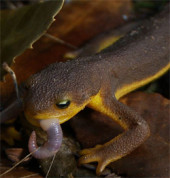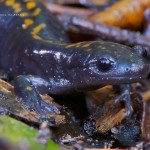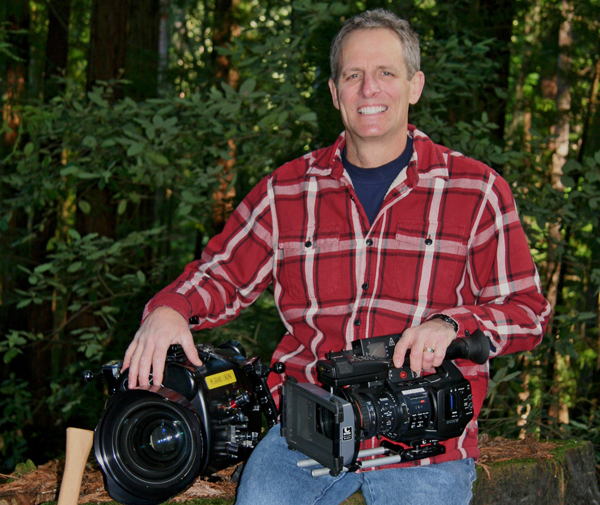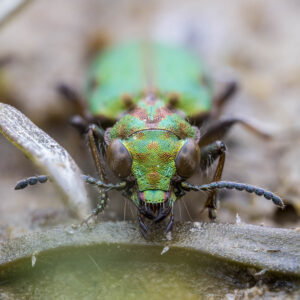Lance Milbrand has spent more than 27 years as an independent filmmaker specializing in films about wild animals and marine life. He’s donned his scuba gear to film the endangered Devils Hole pupfish in a Death Valley cave and a school of Galapagos sharks off the coast of Mexico. On land, he’s chronicled park rangers’ attempts to chase black bears from campers’ tents at Yosemite. But Lance’s most recent subjects are amphibious in nature: the California newt and the Santa Cruz long-toed salamander. He took a break from crawling around ponds and creeks in Santa Cruz in search of his quarry to chat with us about his latest projects.
BN: Where are you from originally?
LM: I grew up in Fort Lauderdale but I lived in Carlsbad, California for 33 years. Then I moved up here to Los Gatos last year when my wife got a job in Silicon Valley.

BN: What inspired you to do a film about newts?
LM: When we were moving in to our new home it started to rain. I opened the front door to go get another load and there was a newt on the doormat. That’s how it started, along with my appreciation for the surrounding environment. I’ve moved from an area where the neighbors were ten feet away to living in the forest.
BN: So that spawned the kids’ film “Walk Like a Newt”?
LM: Yes, I was thinking about a concept for a film on newts, and I’d gathered many hours of footage. In Monterey I happened to meet up with my longtime music composer Eddie Freeman. He said he could create a soundtrack, and so a bit of that original film footage morphed into a short newt “musical” for kids. It’s a one-minute segment with scant educational value, but it’s fun, and if you can get a kid to walk out of a film and say, “Walk like a newt!”, then you’ve succeeded!
BN: How did you end up partnering with the Santa Cruz Museum of Natural History?
LM: I was trying to find a partner like I’d had in Southern California (Orange County Parks) who could use a wildlife filmmaker on a consistent basis. I contacted the local land trusts and environmental organizations, and that led me to the museum. I showed them a 25-minute version of the newt film and then Dan Harder, the museum’s executive director, invited me to discuss working on an educational film that would appeal to both kids and adults. That film-in-progress, which we’re currently raising money for, is designed to go with a new exhibit that will be part of the museum’s upcoming program expansion. The tentative title is “World of the California Newt,” and the theme is “What would a newt see during its twenty-year lifespan?” The footage from my “Walk Like a Newt” film will be incorporated into this movie but edited differently to achieve the educational goals of the film. And, if the movie is funded, I’ll be giving the museum “Walk Like a Newt” gratis.
BN: How much money have you raised so far for this film?
LM: To date we have 25 backers for the project and have raised just over $2,000 through our Kickstarter campaign, out of a goal of $35,000. It’s a long road. I know more people love newts and their habitat; I just need to find them.
BN: What’s the hardest thing about being a wildlife filmmaker?
LM: The hardest part is pitching the film and getting it approved and funded. It’s a lot easier to go out and shoot the wildlife. But there are still technical challenges.
BN: What particular challenges have you encountered filming newts?
LM: Of course, the lighting is a challenge, because newts like rain. Close-ups are key in wildlife filming, and in dark conditions, if your subject moves just a half-inch, it goes out of focus. (We don’t use auto focus cameras – it’s all focused by hand.) When I am on my hands and knees or laying in a creek, I may not moving for a long time and I can get very cold; in those conditions, even my breathing effects the steadiness of my shots.
And it’s really difficult to keep your equipment clean while you work, especially outside with wind and water.

BN: And what about the long-toed salamander? Is this a separate obsession? Will it be part of the newt film?
LM: I’m shooting footage of the Santa Cruz long-toed salamander in the hope that one day soon I will be able to fund and make a film about it, too. The long-toed salamander (an endangered sub-species and one of the rarest California salamanders), poses a greater challenge for me than the newts do: It’s so hard to find: You can go out there many times and get nothing. But once you find it, it’s like getting a kiss from the prettiest girl in high school! No one else has it. Plus, I need to connect with the U.S. Fish & Wildlife Service so they can help me get permission from property owners to gain access to the private lands where its mating ponds are located.
BN: Tell us more about this rarely-seen salamander….
LM: During the rainy season, long-toed salamanders travel at night from the oak trees where they live to the ponds where they mate. They can only be found in a few isolated ponds in the Santa Cruz area(Ed: ponds have to be “vernal”, or seasonal, in order to support long-toed salamander reproduction; otherwise they’ll get eaten by non-native bullfrogs and fish. See the BN article “Land of the Salamander“).
BN: Do you have to use a special camera to get the close-ups? The camera in your photo looks like a monster!
LM: The cameras today continue to get smaller, more powerful, and less expensive, but the highest quality cameras remain big and expensive. My underwater camera and its waterproof housing weigh in at 44 pounds. I have a special wide angle lens that shoots 110 degrees and a macro lens which shows amazing details.
BN: How would you advise people who want to get started in nature filming?
LM: Tough question, because I learned from professionals before the era of “instant gratification” – that is, I had to work with real film. I would say, pick a nature subject that you enjoy that’s close to your home, buy the best equipment you can afford, go out and shoot your subject by studying its behavior, and learn to edit your own material. And then listen to Neil Young’s “Harvest Moon” as much as possible during editing.
BN: What’s your favorite spot to hike or film in the Bay Area since you’ve arrived here?
LM: Hmm, redwood forest, Point Lobos diving …. The redwood forest wins!
>> To learn more about Lance’s film projects, visit his website. And check out Lance’s “World of the California Newt” Kickstarter campaign.





